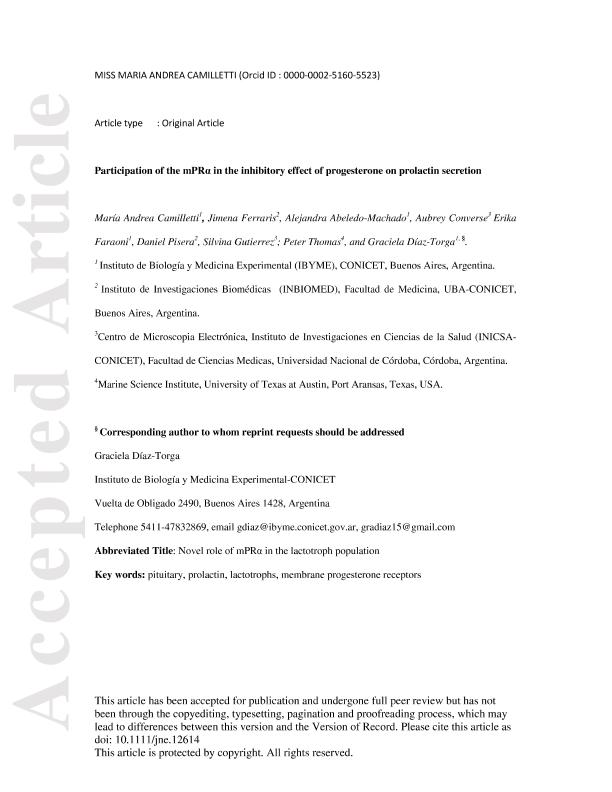Mostrar el registro sencillo del ítem
dc.contributor.author
Camilletti, María Andrea

dc.contributor.author
Ferraris, Maria Jimena

dc.contributor.author
Abeledo Machado, Alejandra Inés

dc.contributor.author
Converse, Aubrey
dc.contributor.author
Faraoni, Erika Yanil

dc.contributor.author
Pisera, Daniel Alberto

dc.contributor.author
Gutiérrez, Silvina

dc.contributor.author
Thomas, Peter
dc.contributor.author
Díaz Torga, Graciela
dc.date.available
2019-10-21T21:13:51Z
dc.date.issued
2018-09
dc.identifier.citation
Camilletti, María Andrea; Ferraris, Maria Jimena; Abeledo Machado, Alejandra Inés; Converse, Aubrey; Faraoni, Erika Yanil; et al.; Participation of membrane progesterone receptor α in the inhibitory effect of progesterone on prolactin secretion; Wiley Blackwell Publishing, Inc; Journal of Neuroendocrinology; 30; 9; 9-2018; 1-32
dc.identifier.issn
0953-8194
dc.identifier.uri
http://hdl.handle.net/11336/86766
dc.description.abstract
The membrane progesterone receptors (mPRα, mPRβ, mPRγ, mPRδ and mPRε) are known to mediate rapid nongenomic progesterone functions in different cell types. However, the functions of these receptors in the pituitary have not been reported to date. In the present study, we show that the expression of mPRα was the highest among the mPRs in the rat anterior pituitary gland. Immunostaining of mPRα was detected in somatotrophs, gonadotrophs and lactotrophs. Interestingly, 63% of mPRα-positive cells within the pituitary were lactotrophs, suggesting that mPRα is involved in controlling prolactin (PRL) secretion in the pituitary. To test this hypothesis, rat pituitaries were incubated (1 hour) with either progesterone (P4) or the mPRα-specific agonist Org OD 02-0. PRL secretion was then measured by radioimmunoassay. The results of this experiment revealed that both P4 and Org OD 02-0 decreased PRL secretion. Moreover, the results from the GH3 cell line (CCL-82.1) showed that P4 and Org OD 02-0 inhibited PRL release, although the nuclear PR agonist R5020 was ineffective. Our investigation of the cellular mechanisms behind mPRα activity indicated that both P4 and Org OD 02-0 decreased cAMP accumulation, whereas R5020 was ineffective. In addition, the Org OD 02-0-effect on PRL release was blocked by pretreatment with pertussis toxin, an inhibitor of Go/Gi proteins. Because transforming growth factor (TGF)β1 is a potent inhibitor of PRL secretion in lactotrophs, we lastly evaluated whether TGFβ1 was activated by progesterone and whether this effect was mediated by mPRα. Our results showed that P4 and Org OD 02-0, but not R5020, increased active TGFβ1 levels. This effect was not observed when cells were transfected with mPRα-small interfering RNA. Taken together, these data provide new evidence suggesting that mPRα mediates the progesterone inhibitory effect on PRL secretion through both decreases in cAMP levels and activation of TGFβ1 in the lactotroph population.
dc.format
application/pdf
dc.language.iso
eng
dc.publisher
Wiley Blackwell Publishing, Inc

dc.rights
info:eu-repo/semantics/openAccess
dc.rights.uri
https://creativecommons.org/licenses/by-nc-sa/2.5/ar/
dc.subject
LACTOTROPHS
dc.subject
MEMBRANE PROGESTERONE RECEPTORS
dc.subject
PITUITARY
dc.subject
PROLACTIN
dc.subject.classification
Fisiología

dc.subject.classification
Medicina Básica

dc.subject.classification
CIENCIAS MÉDICAS Y DE LA SALUD

dc.title
Participation of membrane progesterone receptor α in the inhibitory effect of progesterone on prolactin secretion
dc.type
info:eu-repo/semantics/article
dc.type
info:ar-repo/semantics/artículo
dc.type
info:eu-repo/semantics/publishedVersion
dc.date.updated
2019-10-15T19:39:55Z
dc.identifier.eissn
1365-2826
dc.journal.volume
30
dc.journal.number
9
dc.journal.pagination
1-32
dc.journal.pais
Reino Unido

dc.journal.ciudad
Londres
dc.description.fil
Fil: Camilletti, María Andrea. Consejo Nacional de Investigaciones Científicas y Técnicas. Instituto de Biología y Medicina Experimental. Fundación de Instituto de Biología y Medicina Experimental. Instituto de Biología y Medicina Experimental; Argentina
dc.description.fil
Fil: Ferraris, Maria Jimena. Consejo Nacional de Investigaciones Científicas y Técnicas. Oficina de Coordinación Administrativa Houssay. Instituto de Investigaciones Biomédicas. Universidad de Buenos Aires. Facultad de Medicina. Instituto de Investigaciones Biomédicas; Argentina
dc.description.fil
Fil: Abeledo Machado, Alejandra Inés. Consejo Nacional de Investigaciones Científicas y Técnicas. Instituto de Biología y Medicina Experimental. Fundación de Instituto de Biología y Medicina Experimental. Instituto de Biología y Medicina Experimental; Argentina
dc.description.fil
Fil: Converse, Aubrey. Marine Science Institute, University Of Texas At Austin; Estados Unidos
dc.description.fil
Fil: Faraoni, Erika Yanil. Consejo Nacional de Investigaciones Científicas y Técnicas. Instituto de Biología y Medicina Experimental. Fundación de Instituto de Biología y Medicina Experimental. Instituto de Biología y Medicina Experimental; Argentina
dc.description.fil
Fil: Pisera, Daniel Alberto. Consejo Nacional de Investigaciones Científicas y Técnicas. Oficina de Coordinación Administrativa Houssay. Instituto de Investigaciones Biomédicas. Universidad de Buenos Aires. Facultad de Medicina. Instituto de Investigaciones Biomédicas; Argentina
dc.description.fil
Fil: Gutiérrez, Silvina. Consejo Nacional de Investigaciones Científicas y Técnicas. Centro Científico Tecnológico Conicet - Córdoba. Instituto de Investigaciones en Ciencias de la Salud. Universidad Nacional de Córdoba. Instituto de Investigaciones en Ciencias de la Salud; Argentina
dc.description.fil
Fil: Thomas, Peter. University of Texas at Austin; Estados Unidos
dc.description.fil
Fil: Díaz Torga, Graciela. Consejo Nacional de Investigaciones Científicas y Técnicas. Instituto de Biología y Medicina Experimental. Fundación de Instituto de Biología y Medicina Experimental. Instituto de Biología y Medicina Experimental; Argentina
dc.journal.title
Journal of Neuroendocrinology

dc.relation.alternativeid
info:eu-repo/semantics/altIdentifier/url/http://doi.wiley.com/10.1111/jne.12614
dc.relation.alternativeid
info:eu-repo/semantics/altIdentifier/doi/http://dx.doi.org/10.1111/jne.12614
Archivos asociados
